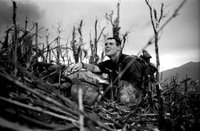
Most people won't be able to connect Catherine Leroy with anything significant. That's typical of newspaper readers. We rarely connect the photographer with the photograph. Fame comes from within the community of photo-journalists.
I met Catherine Leroy on some piece of African dirt where people with opposing ideologies had taken to slaughtering each other to make their point. I was surprized at her diminutive size. At 5 feet tall and less than 100 pounds, she did not present the image one would expect of one the world's most renown and fearless combat photo-journalists.
Leroy was not a professional photographer when she arrived in Viet Nam. Two years later she would be credited with having captured the essence of the horror of ground warfare. And, she did it by getting in there with the troops and being where the bullets were flying.
Her photographs were unique. She was accused of photographing the war from a woman's perspective - different than what the corps of male photographers were doing at the time. I have never believed that.
Catherine Leroy presented a side of war that is usually only reserved for frontline grunts. There was nothing feminine about her work. As opposed to the heroism and the moments of memorial symbolism which combat photographers often captured, Leroy went for the troops themselves and produced a pictorial representation of the torment and suffering on the ground. In time, the US military command in Viet Nam would come to detest her work. Some called her a "ghoul" while others would praise her for telling the real story of intense close combat.
 Perhaps her most famous photograph from the Viet Nam war was her 1967 Corpsman In Anguish, a shot that captured the frustration of navy medic Vernon Wike, serving with the 3rd Marines, unable to save his mortally wounded buddy. In fact, it is a series of three photos and taken together they tell a story most of us would not want to know. To a rifleman on the ground it constitutes something known as "kissing the dead" - the last act of a medic who realizes that his patient will die, no matter what he does.
Perhaps her most famous photograph from the Viet Nam war was her 1967 Corpsman In Anguish, a shot that captured the frustration of navy medic Vernon Wike, serving with the 3rd Marines, unable to save his mortally wounded buddy. In fact, it is a series of three photos and taken together they tell a story most of us would not want to know. To a rifleman on the ground it constitutes something known as "kissing the dead" - the last act of a medic who realizes that his patient will die, no matter what he does. 
Leroy paid heavily for her photographs. She was seriously wounded, more than once. She was the only accredited Viet Nam photo-journalist to para-jump into action, having made a combat jump with the 173rd Airborne in 1967. During the Tet offensive she was captured by the North Vietnamese in the battle for Hue. Her captors eventually released her when they realized she was a French journalist, but not before she photographed them in action.
Her Tet photo-essay made the cover of Life magazine.

And, then she left Viet Nam. She described herself as seriously shell-shocked. Her penchant for being amid the fighting had scarred her permanently. But, she had changed combat photo-journalism forever. No longer would the horror of actual combat be hidden from the public. Others would follow her lead and emulate her style, but none would match the fearless determination to show war through the eye's of a soldier using a lens which worked from the firing line.
Yesterday the world lost Catherine Leroy. She died at age 60.
Goodbye, Catherine. You gave more than you took. Those who knew you, even briefly, will miss the heavily accented English peppered with idioms which came from learning a language while living in the field with US marines.
 And, we will always have the story you told in pictures.
And, we will always have the story you told in pictures.(Click on images to enlarge)
Photographs copyright © Catherine Leroy

No comments:
Post a Comment